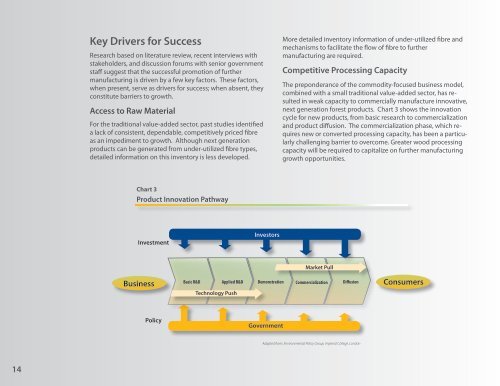Generating More Value from Our Forests - Ministry of Forests
Generating More Value from Our Forests - Ministry of Forests
Generating More Value from Our Forests - Ministry of Forests
You also want an ePaper? Increase the reach of your titles
YUMPU automatically turns print PDFs into web optimized ePapers that Google loves.
14<br />
Key Drivers for Success<br />
Research based on literature review, recent interviews with<br />
stakeholders, and discussion forums with senior government<br />
staff suggest that the successful promotion <strong>of</strong> further<br />
manufacturing is driven by a few key factors. These factors,<br />
when present, serve as drivers for success; when absent, they<br />
constitute barriers to growth.<br />
Access to Raw Material<br />
For the traditional value-added sector, past studies identified<br />
a lack <strong>of</strong> consistent, dependable, competitively priced fibre<br />
as an impediment to growth. Although next generation<br />
products can be generated <strong>from</strong> under-utilized fibre types,<br />
detailed information on this inventory is less developed.<br />
Chart 3<br />
Product Innovation Pathway<br />
Investment<br />
Business<br />
Policy<br />
Basic R&D<br />
Technology Push<br />
Investors<br />
Government<br />
<strong>More</strong> detailed inventory information <strong>of</strong> under-utilized fibre and<br />
mechanisms to facilitate the flow <strong>of</strong> fibre to further<br />
manufacturing are required.<br />
Competitive Processing Capacity<br />
The preponderance <strong>of</strong> the commodity-focused business model,<br />
combined with a small traditional value-added sector, has resulted<br />
in weak capacity to commercially manufacture innovative,<br />
next generation forest products. Chart 3 shows the innovation<br />
cycle for new products, <strong>from</strong> basic research to commercialization<br />
and product diffusion. The commercialization phase, which requires<br />
new or converted processing capacity, has been a particularly<br />
challenging barrier to overcome. Greater wood processing<br />
capacity will be required to capitalize on further manufacturing<br />
growth opportunities.<br />
Market Pull<br />
Applied R&D Demonstration Commercialization Diffusion<br />
Adapted <strong>from</strong>: Environmental Policy Group, Imperial College, London<br />
Consumers

















